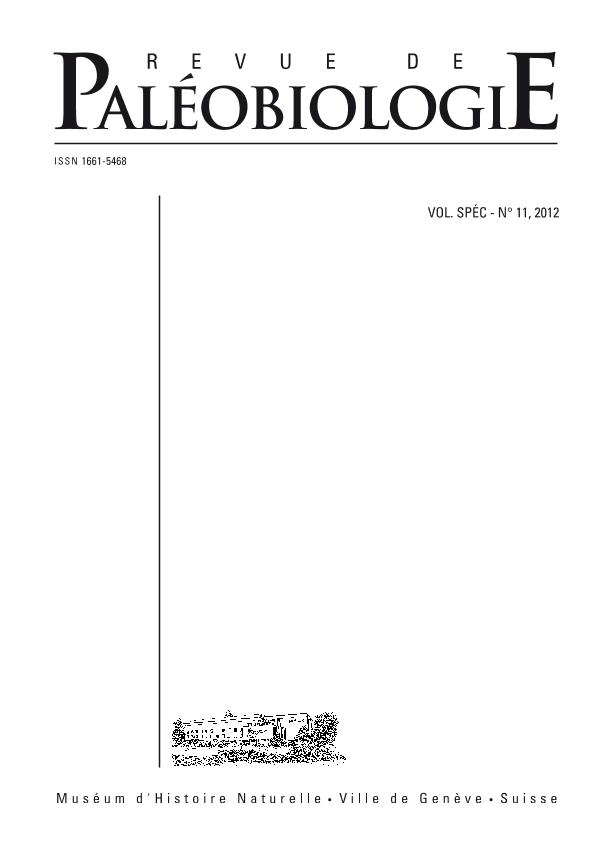Mostrar el registro sencillo del ítem
dc.contributor.author
Iglesia Llanos, Maria Paula

dc.date.available
2019-03-07T17:47:14Z
dc.date.issued
2012-06
dc.identifier.citation
Iglesia Llanos, Maria Paula; Palaeomagnetic study of the Jurassic from Argentina: magnetostratigraphy and palaeogeography of South America; Muséum d'histoire naturelle de la Ville de Genève; Revue de Paléobiologie; 11; Esp.; 6-2012; 151-168
dc.identifier.issn
0253-6730
dc.identifier.uri
http://hdl.handle.net/11336/71174
dc.description.abstract
A palaeomagnetic study has been carried out in five sections of Lower Jurassic age from the Neuquén basin. These are made up of ammonite-bearing sedimentary rocks and subordinately, volcanic rocks. Sampled sections are located to the north along the Atuel river (Hettangian to Toarcian) and to the centre (Pliensbachian to Toarcian) of the basin. The palaeomagnetic study shows two magnetic components carried by titanomagnetites, one soft with a direction in coincidence with the local dipolar field, and another harder that is interpreted as the original Jurassic based on the field tests for palaeomagnetic stability. From the polarity successions obtained in each locality, a composite magnetostratigraphic scale has been constructed that represents the first of the Southern Hemisphere. Consequently, 11 zones of dominant reverse polarity (JR1 to JR11), and 12 zones of dominant normal polarity (JN1 to JN12), were identified, which have been tied to 19 ammonite zones of the Andean Region. These, in turn, have been correlated to the international geomagnetic time scale. A good fit between scales is observed, allowing to date intervals with no diagnostic fossils such as in Puesto Araya with the Sinemurian-Pliensbachian boundary or in Rajapalo with the Pliensbachian-Toarcian limit. On the other hand, two palaeomagnetic poles have been calculated, one for the Hettangian-Sinemurian interval (223°E, 51°S, A95= 6°, N = 25) and the other for the Pliensbachian-Toarcian (67°E, 74°S, A95= 5°, N = 52). Such poles were combined with others from the literature to obtain the apparent polar wander (APW) path for South America, that turns out remarkably dissimilar with the classical ones that show the continent in a more or less stationary position throughout the Mesozoic. The new APW path suggests that South America would have rotated clockwise while it moved northward. We also show Eurasia?s path revealing the same shape and chronology of tracks. These latitudinal changes that we observed from the palaeomagnetic data, are sustained by palaeoecological data.
dc.format
application/pdf
dc.language.iso
eng
dc.publisher
Muséum d'histoire naturelle de la Ville de Genève
dc.rights
info:eu-repo/semantics/openAccess
dc.rights.uri
https://creativecommons.org/licenses/by-nc-sa/2.5/ar/
dc.subject
Jurassic
dc.subject
Neuquen Basin
dc.subject
Palaeogeography
dc.subject
Magnetostratigraphy
dc.subject.classification
Meteorología y Ciencias Atmosféricas

dc.subject.classification
Ciencias de la Tierra y relacionadas con el Medio Ambiente

dc.subject.classification
CIENCIAS NATURALES Y EXACTAS

dc.title
Palaeomagnetic study of the Jurassic from Argentina: magnetostratigraphy and palaeogeography of South America
dc.type
info:eu-repo/semantics/article
dc.type
info:ar-repo/semantics/artículo
dc.type
info:eu-repo/semantics/publishedVersion
dc.date.updated
2019-01-16T18:13:20Z
dc.identifier.eissn
1661-5468
dc.journal.volume
11
dc.journal.number
Esp.
dc.journal.pagination
151-168
dc.journal.pais
Suiza

dc.journal.ciudad
Geneve
dc.description.fil
Fil: Iglesia Llanos, Maria Paula. Universidad de Buenos Aires. Facultad de Ciencias Exactas y Naturales. Departamento de Geología. Instituto de Geofísica "Daniel Valencio"; Argentina. Consejo Nacional de Investigaciones Científicas y Técnicas. Oficina de Coordinación Administrativa Ciudad Universitaria. Instituto de Geociencias Básicas, Aplicadas y Ambientales de Buenos Aires. Universidad de Buenos Aires. Facultad de Ciencias Exactas y Naturales. Instituto de Geociencias Básicas, Aplicadas y Ambientales de Buenos Aires; Argentina
dc.journal.title
Revue de Paléobiologie
dc.relation.alternativeid
info:eu-repo/semantics/altIdentifier/url/http://institutions.ville-geneve.ch/fr/mhn/frontpage/revue-de-paleobiologie/revue-de-paleobiologie-liste/
Archivos asociados
